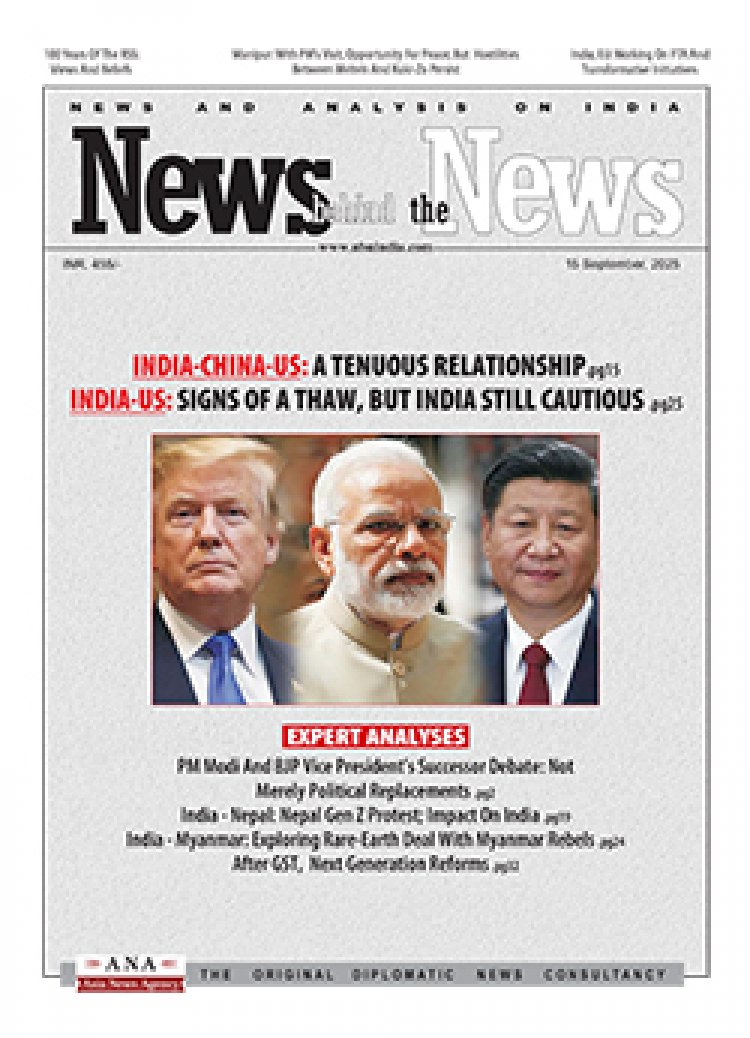India - China: Rivalry Extends Beyond Land Borders
STORIES, ANALYSES, EXPERT VIEWS

Defence Minister Rajnath Singh firmly conveyed India’s stance on cross-border terrorism to Chinese Defence Minister Admiral Don Jun during a bilateral meeting held on the sidelines of the SCO Defence Ministers’ Meeting in China. He emphasized that Operation Sindoor will continue, reaffirming India’s resolve to defend itself against any cross-border terror activities. Singh also underscored that neighbouring countries must take note of this unwavering commitment, and urged China to avoid adding new complexities. (Please see the story on SCO in the International chapter also)
In the meeting, a discussion was also held on de-escalation, disengagement, demarcation and Special Representatives (SR) level talks. Maintaining peace along the borders and enhancing international relations should remain focus of both sides.
China halts shipments of specialty fertilisers
In its latest anti-India move, China has halted shipments of specialty fertilisers used to increase the yields of fruits, vegetables and other remunerative crops to India for the last two months. China, a global supplier of agricultural inputs, continues to export them to other nations. India imports about 80% of its supplies of these chemicals from China. India does not have the technology to produce specialty fertilisers as volumes until now have been low, making it unviable for companies to set up manufacturing facilities locally.
Beijing ‘testing the waters’ of regional resistance
In the maritime domain, with Washington’s strategic bandwidth currently stretched by developments in West Asia, The Statesman writes “Beijing appears to be ‘testing the waters’ of regional resistance ~ especially the resilience of the US-Japan alliance. This has serious implications for India which seeks to restrict the Chinese hegemony.”
China’s latest naval manoeuvres in the western Pacific are a sharp reminder that great power rivalry is no longer confined to the pages of strategy documents ~ it is playing out in real-time on contested waters. The concurrent deployment of both Chinese aircraft carriers, the Liaoning and Shandong, near Japanese maritime zones marks a clear departure from previous patterns of military signalling. The intensity, duration, and scope of the exercises, including over 500 aircraft landings and close intercepts of Japanese surveillance planes, underscore a shift from symbolic presence to demonstrative assertion. What stands out is not simply the show of force, but the timing and precision of the operation.
Dealing with China’s restrictions on exports of rare earths
More pointedly, India needs to find an answer to China restricting export of critical minerals and rare earth elements, used across several key sectors, ranging from electronics to renewables, automobiles and defence. These are increasingly playing a vital role in the global economy, including India’s. For instance, lithium, nickel and cobalt are used in lithium-ion batteries. Dysprosium and neodymium, and tellurium, indium, and gallium are used in wind turbines and photovoltaic cells respectively. These minerals are central to the fourth industrial revolution. Restrictions over their supply, which can disrupt production processes across several sectors, have thus become central to the global trade war.
China holds a position of dominance. As per the International Energy Agency, the country accounts for a 35 per cent share in the refining of nickel, 50-70 per cent of lithium and cobalt and around 90 per cent for rare earth elements. China not only dominates the production of rare earths, but also has the most reserves. As per data from the US Geological Survey, the country’s reserves have been estimated at 44 million metric tons. Brazil’s reserves have been pegged at 21 million metric tons, India’s at 6.9 million, Australia’s at 5.7, Russia’s at 3.8 million and Vietnam’s at 3.5 million.
The recent framework agreed to by the US and China also involves the easing of rare earth supplies. Most counties are however, aggressively exploring this segment. In 2025, India launched a National Critical Mineral Mission to help achieve self-reliance in the critical mineral sector. Under this, the Geological Survey of India is expected to conduct 1,200 exploration projects by 2030-31. This issue needs to be tackled at multiple levels, according to The Indian Express. “The objective should be to secure supplies in the short term so as to prevent disruptions across industries, while also focusing on expanding domestic exploration, mining and processing and firming up alternative sources of supply."
India’s subsidy scheme: In this context, it is understood that the Indian government will decide on a subsidy scheme to support domestic production of rare earth magnets within 15 to 20 days, Stakeholder consultations are currently underway to determine the exact quantum of subsidy to be offered.
ET had reported last week citing a government official that India has firmed up a ₹3,500-5,000 crore scheme to incentivise production of rare earth minerals and derived magnets in the country and could be approved in a fortnight.
















